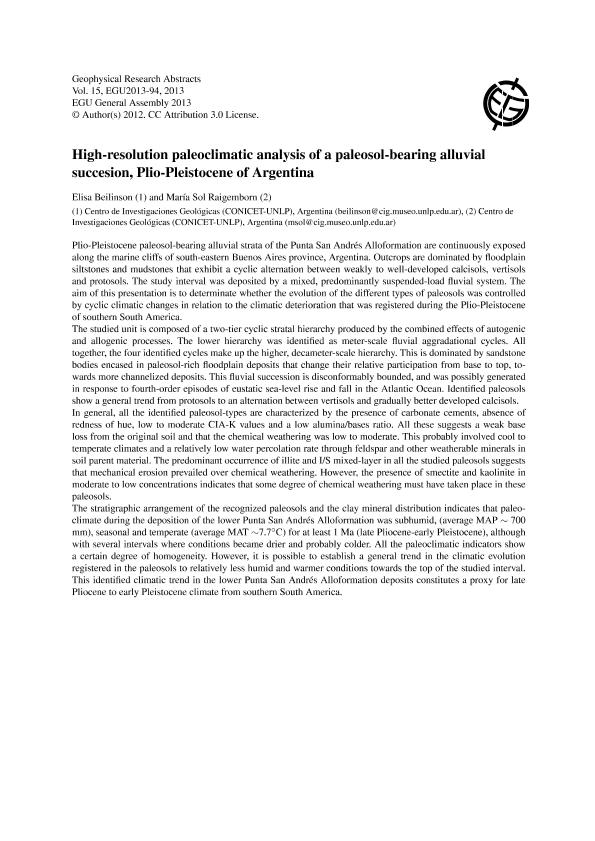Mostrar el registro sencillo del ítem
dc.contributor.author
Beilinson, Elisa
dc.contributor.author
Raigemborn, María Sol

dc.date.available
2024-04-18T13:23:01Z
dc.date.issued
2013
dc.identifier.citation
High-resolution paleoclimatic analysis of a paleosol-bearing alluvial succesion, Plio-Pleistocene of Argentina; EGU General Assembly 2013; Vienna; Austria; 2013; 1-1
dc.identifier.issn
1607-7962
dc.identifier.uri
http://hdl.handle.net/11336/233454
dc.description.abstract
Plio-Pleistocene paleosol-bearing alluvial strata of the Punta San Andrés Alloformation are continuously exposed along the marine cliffs of south-eastern Buenos Aires province, Argentina. Outcrops are dominated by floodplain siltstones and mudstones that exhibit a cyclic alternation between weakly to well-developed calcisols, vertisols and protosols. The study interval was deposited by a mixed, predominantly suspended-load fluvial system. The aim of this presentation is to determinate whether the evolution of the different types of paleosols was controlled by cyclic climatic changes in relation to the climatic deterioration that was registered during the Plio-Pleistocene of southern South America. The studied unit is composed of a two-tier cyclic stratal hierarchy produced by the combined effects of autogenic and allogenic processes. The lower hierarchy was identified as meter-scale fluvial aggradational cycles. All together, the four identified cycles make up the higher, decameter-scale hierarchy. This is dominated by sandstone bodies encased in paleosol-rich floodplain deposits that change their relative participation from base to top, towards more channelized deposits. This fluvial succession is disconformably bounded, and was possibly generated in response to fourth-order episodes of eustatic sea-level rise and fall in the Atlantic Ocean. Identified paleosols show a general trend from protosols to an alternation between vertisols and gradually better developed calcisols. In general, all the identified paleosol-types are characterized by the presence of carbonate cements, absence of redness of hue, low to moderate CIA-K values and a low alumina/bases ratio. All these suggests a weak base loss from the original soil and that the chemical weathering was low to moderate. This probably involved cool to temperate climates and a relatively low water percolation rate through feldspar and other weatherable minerals in soil parent material. The predominant occurrence of illite and I/S mixed-layer in all the studied paleosols suggests that mechanical erosion prevailed over chemical weathering. However, the presence of smectite and kaolinite in moderate to low concentrations indicates that some degree of chemical weathering must have taken place in these paleosols. The stratigraphic arrangement of the recognized paleosols and the clay mineral distribution indicates that paleoclimate during the deposition of the lower Punta San Andrés Alloformation was subhumid, (average MAP ~ 700 mm), seasonal and temperate (average MAT ~7.7°C) for at least 1 Ma (late Pliocene-early Pleistocene), although with several intervals where conditions became drier and probably colder. All the paleoclimatic indicators show a certain degree of homogeneity. However, it is possible to establish a general trend in the climatic evolution registered in the paleosols to relatively less humid and warmer conditions towards the top of the studied interval. This identified climatic trend in the lower Punta San Andrés Alloformation deposits constitutes a proxy for late Pliocene to early Pleistocene climate from southern South America.
dc.format
application/pdf
dc.language.iso
eng
dc.publisher
Copernicus Publications

dc.rights
info:eu-repo/semantics/openAccess
dc.rights.uri
https://creativecommons.org/licenses/by/2.5/ar/
dc.subject
PALAECLIMATE
dc.subject
PALAEOSOLS
dc.subject
ALLUVIAL SUCCESSION
dc.subject
PLIO-PLEISTICENE
dc.subject.classification
Geología

dc.subject.classification
Ciencias de la Tierra y relacionadas con el Medio Ambiente

dc.subject.classification
CIENCIAS NATURALES Y EXACTAS

dc.title
High-resolution paleoclimatic analysis of a paleosol-bearing alluvial succesion, Plio-Pleistocene of Argentina
dc.type
info:eu-repo/semantics/publishedVersion
dc.type
info:eu-repo/semantics/conferenceObject
dc.type
info:ar-repo/semantics/documento de conferencia
dc.date.updated
2024-04-15T17:34:27Z
dc.journal.volume
15
dc.journal.pagination
1-1
dc.journal.pais
Austria

dc.journal.ciudad
Vienna
dc.description.fil
Fil: Beilinson, Elisa. Consejo Nacional de Investigaciones Científicas y Técnicas. Centro Científico Tecnológico Conicet - La Plata. Centro de Investigaciones Geológicas. Universidad Nacional de La Plata. Facultad de Ciencias Naturales y Museo. Centro de Investigaciones Geológicas; Argentina
dc.description.fil
Fil: Raigemborn, María Sol. Consejo Nacional de Investigaciones Científicas y Técnicas. Centro Científico Tecnológico Conicet - La Plata. Centro de Investigaciones Geológicas. Universidad Nacional de La Plata. Facultad de Ciencias Naturales y Museo. Centro de Investigaciones Geológicas; Argentina
dc.relation.alternativeid
info:eu-repo/semantics/altIdentifier/url/https://meetingorganizer.copernicus.org/EGU2013/posters/11606
dc.relation.alternativeid
info:eu-repo/semantics/altIdentifier/url/https://meetingorganizer.copernicus.org/EGU2013/EGU2013-94.pdf
dc.conicet.rol
Autor

dc.conicet.rol
Autor

dc.coverage
Internacional
dc.type.subtype
Congreso
dc.description.nombreEvento
EGU General Assembly 2013
dc.date.evento
2013-04-07
dc.description.ciudadEvento
Vienna
dc.description.paisEvento
Austria

dc.type.publicacion
Journal
dc.description.institucionOrganizadora
European Geosciences Union
dc.source.revista
Geophysical Research Abstracts
dc.date.eventoHasta
2013-04-12
dc.type
Congreso
Archivos asociados
